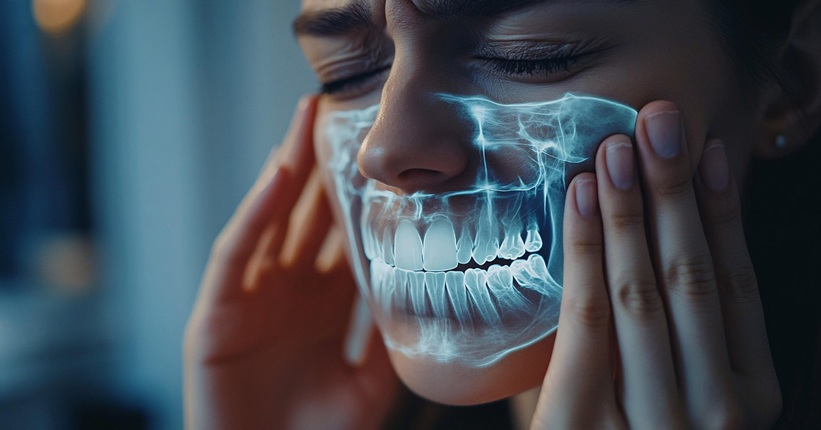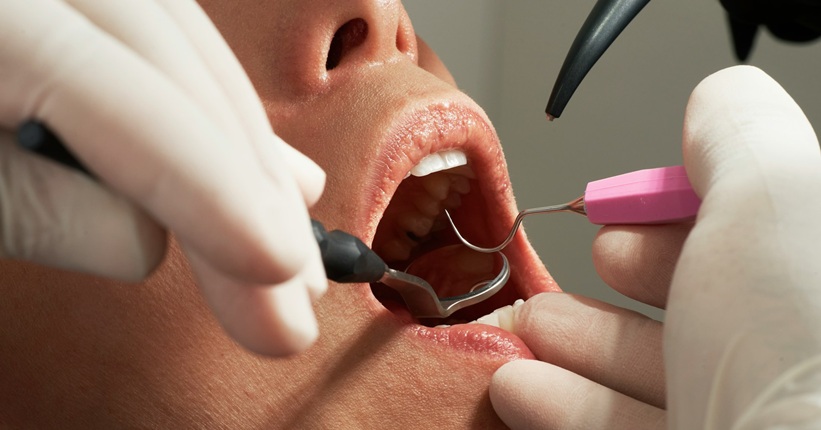
Throbbing toothache – what does it mean and how can it be treated?
A throbbing toothache is one of the most disturbing and troublesome symptoms we can experience. It often appears suddenly, is rhythmic in nature, and intensifies when bending over, eating, or lying down. Although many of us try to relieve it with home remedies, such pain is usually not accidental—it is a sign that there is inflammation in the tooth or surrounding tissues that requires professional intervention. What can throbbing tooth pain mean, what are its most common causes, and how can it be effectively treated to prevent more serious complications?
What does a pulsating toothache mean?
Pulsating toothache is a type of pain that is often felt as a rhythmic heartbeat or beats within the tooth, usually intensifying when lying down or while eating. The pulsating nature of pain suggests the presence of inflammation and increased pressure in the tissues, so it should not be ignored.
A pulsating toothache can mean something different depending on the circumstances and situation in which this symptom occurs.
Pulsating toothache when bending
Pulsating toothache when bending is often a symptom of inflammation within the pulp of the tooth or tissues surrounding the root. When we tilt our head down, the pressure in the face and mouth area increases, which can aggravate pain complaints, especially if there is an inflammatory or purulent process in the tooth. Such pain may also indicate an apical abscess or problems with the maxillary sinus, which is located close to the roots of the upper molars. In any case, a throbbing pain that intensifies with a change in body position requires urgent dental evaluation.
Pulsating toothache after root canal treatment
Pulsating toothache after root canal treatment can be a normal reaction of the body to interference with tissues, especially in the first days after surgery; however, if it lasts longer or worsens, it can indicate complications. The most common causes are inaccurate cleaning of the canals, leaving infected tissue, leaky filling, or infection of the periapical tissues. Throbbing pain, especially when accompanied by swelling or a feeling of “pushing out” of the tooth, may suggest a developing inflammation or abscess. In such a situation, a re-consultation with the dentist and possible complementary treatment is necessary.
Pulsating toothache under the filling
Pulsating toothache under the filling may indicate developing inflammation of the pulp, or tissues inside the tooth, despite prior treatment. Such pain often indicates that the caries may have gone deeper than initially assessed, or that bacteria have penetrated the inside of the tooth before the filling was placed. It can also indicate leakage of the seal, microcracks, or the reaction of the pulp to mechanical and chemical stimuli. If the throbbing pain persists, intensifies, or is accompanied by hypersensitivity to heat, a re-evaluation of the tooth by the dentist is necessary - root canal treatment may be needed.
Pulsating pain of a dead tooth
Pulsating pain in a dead tooth, that is, one in which the pulp has already been removed (e.g., after root canal treatment), may indicate inflammation or infection of the tissues surrounding the root of the tooth. Although the tooth itself no longer has a nerve, the infection can develop in the bone or at the apex of the root, causing pain of a throbbing nature, often intensifying when recording or lying down. This may be a symptom of a relapse of inflammation, the presence of periapical lesions, or obstructive ducts that have not previously been completely cleared. Such pain always requires re-diagnosis and may be associated with the need for repeated root canal treatment or surgery.
Pulsating toothache with dressing
A throbbing toothache with a temporary dressing can be a normal reaction after surgery, especially if the tooth has been root canal-treated or deeply cleaned. However, if the pain intensifies, lasts more than a few days, or is accompanied by symptoms such as swelling, fever, or a feeling of “spreading” in the tooth, this may be evidence of ongoing inflammation in the pulp or in the periapical tissues. It is also possible that the dressing does not sufficiently protect the inside of the tooth from bacteria. In such a situation, you should not delay - a check-up with a dentist is necessary, who will assess whether to change the dressing, take root canal treatment, or implement other measures.
Pulsating toothache after poisoning
Pulsating toothache after poisoning, that is, after putting on a devitalizing dressing intended to “kill” the pulp, can be a normal reaction to the action of the preparation, especially in the first days. Such a dressing contains chemicals that provoke necrosis of the nerve, which is often associated with a temporary increase in pain, also of a pulsating nature. However, if the pain is very severe, does not go away after a few days, or there are additional symptoms such as swelling, fever, or pain when touched, this may be a sign of developing inflammation or abscess. In this case, you should immediately contact the dentist to assess the situation and speed up further root canal treatment.
Home remedies for a throbbing toothache
When a throbbing toothache occurs, the main thing is to make an appointment with the dentist as soon as possible, since such pain usually indicates inflammation, infection, or other serious problems that require treatment. By the time of the visit, you can try to relieve pain complaints on your own. Home remedies for a throbbing toothache can provide temporary relief. Here are some of the most commonly used methods:
1. Rinse with salt and warm water — it has an anti-inflammatory and disinfectant effect. Dissolve half a teaspoon of salt in a glass of warm water and rinse your mouth several times a day.
2. Cold wrap — applied to the outside of the cheek, can help reduce swelling and relieve pain.
3. Cloves or clove oil — contain eugenol, which has an anesthetic and antibacterial effect. You can apply a crushed clove to a sore spot or apply a drop of essential oil to a cotton swab and gently apply it to the tooth.
4. Garlic — has antibacterial properties. You can apply a slightly crushed clove to the aching tooth for a few minutes.
5. Over-the-counter pain relievers — e.g., ibuprofen or paracetamol if there are no contraindications.
Remember that home remedies act only symptomatically and do not remove the cause of the pain. The sooner you react and consult a dentist, the greater the chance of avoiding complications.
What not to do for a throbbing toothache?
With a pulsating toothache, it is forbidden to take actions that can aggravate inflammation or make treatment difficult. What to avoid?
1) Do not apply heat - hot compresses can increase inflammation and accelerate the development of an abscess.
2) Do not press on the sore spot — pressing on the tooth, gum, or cheek can increase pain and worsen inflammation.
3) Do not pierce the swelling or manipulate the tooth - this can lead to the spread of infection.
4) Do not postpone the visit to the dentist - even if the pain temporarily subsides, the cause of the problem can still develop.
5) Do not take painkillers in moderation - especially do not combine them without consultation (eg, ibuprofen with other drugs in the same group).
6) Do not drink alcohol “for a toothache” - it can aggravate inflammation and enter into dangerous drug interactions.
7) Do not chew hard or very hot/cold foods - they can increase pain and damage the tooth.
The main thing: do not wait for it to pass by itself. A throbbing toothache is a signal that something serious is happening and requires evaluation by a dentist.
How long can home remedies be used before visiting a doctor?
Home remedies for throbbing toothache can only be used occasionally and for a very short time - usually no more than 1-2 days. If the pain:
- lasts more than 48 hours,
- get worse despite the use of home remedies or painkillers
- accompanied by swelling, fever, unpleasant taste in the mouth, or general malaise —
Then this is a clear signal that a more serious inflammation has occurred, and an urgent dental consultation is required.
Delaying treatment can lead to abscesses, tissue necrosis, and even the spread of infection to other parts of the body. Home remedies can only alleviate the symptoms — they do not eliminate the cause of the pain.
Other medical conditions...
Pulsating toothache can be associated not only with dental problems, but also with other systemic or ENT diseases. For example:
1) Maxillary sinusitis — can cause pain in the upper teeth, especially when bending, and can be confused with a toothache.
2) Trigeminal neuralgia — causes paroxysmal, sharp pain in the face that can sometimes resemble a throbbing toothache.
3) Bruxism (teeth grinding) — can lead to overstrain and inflammation of the periodontal tissues, which is manifested by pain, and also pulsating.
4) Temporomandibular joint problems — can cause radiating pain to the teeth, especially in the back of the jaw.
5) Heart disease — in rare cases, a toothache can be a pain projected, e.g., with angina pectoris (more often in the elderly).
Therefore, if the toothache is unusual, does not go away despite dental treatment, or is accompanied by other symptoms, it is also worth consulting a general practitioner or ENT doctor.
Content author

Dr. Jędrzej Gącienica-Ciułacz
Dr. Jędrzej Gącienica-Ciułacz is a dentist who, thanks to his cordial approach, facilitates visits even for the most fearful patients. His extraordinary ability to build trust and natural kindness allows patients to feel safe and comfortable from the first moments in the office. He is a doctor who does not recognize the concept of “hopeless case” — instead, he treats every challenge as an opportunity to create a beautiful, healthy smile. By combining his medical knowledge with an individual approach to each patient, he creates an atmosphere of support and understanding.

Start treatment already today!
Make an appointment and discover why our patients recommend us to their loved ones. We will take the utmost care of your smile.


